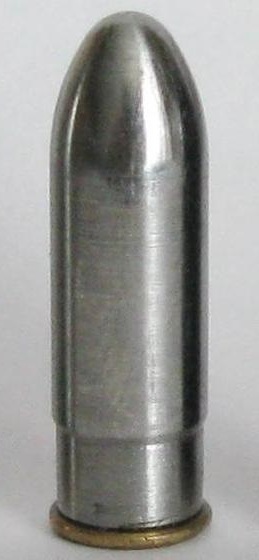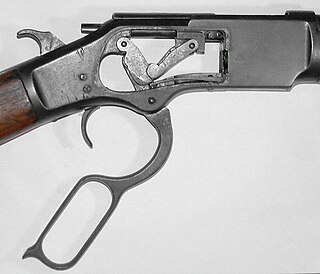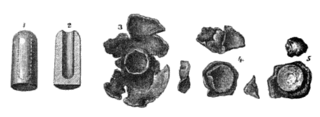

The Rocket Ball was one of the earliest forms of metallic cartridge for firearms, containing bullet and powder in a single, metal-cased unit. [1]


The Rocket Ball was one of the earliest forms of metallic cartridge for firearms, containing bullet and powder in a single, metal-cased unit. [1]
The Rocket Ball, patented in 1848 by Walter Hunt, consisted of a lead bullet with a deep hollow in the rear, running a majority of the length of the cartridge. The hollow, like that of the Minie ball, served to seal the bullet into the bore, but Rocket Ball put the cavity to further use. By packing the deep cavity with powder, and sealing it with a cap with a small hole in the rear for ignition, the Rocket Ball replaced the earlier paper cartridge with a durable package capable of being fed from a magazine. The cap was blown out of the bore upon firing. The Rocket Ball was used in magazine fed lever action guns, allowing the first easily manufactured repeating single chamber firearms. [1]
While the Rocket Ball provided the means of making practical repeating firearms, it was not an ideal solution. The limited volume in the base of the bullet severely limited the amount of powder that could be used, and thus limited the potential velocity and range of the cartridge. With muzzle energy of only about 56 foot-pounds (76 joules), [2] the Rocket Ball was less powerful than even the most feeble of modern "pocket pistol" cartridges, such as .25 ACP.
Despite these limitations, the Rocket Ball was used in a number of attempts at making a commercially successful firearm, culminating in the Volcanic Repeating Arms Company. The Volcanic cartridge went one step further, adding a primer to the cap of the Rocket Ball, making the ammunition completely self-contained. [1]


A firearm is any type of gun that uses an explosive charge and is designed to be readily carried and used by an individual. The term is legally defined further in different countries.

A rifle is a long-barreled firearm designed for accurate shooting and higher stopping power, with a barrel that has a helical pattern of grooves (rifling) cut into the bore wall. In keeping with their focus on accuracy, rifles are typically designed to be held with both hands and braced firmly against the shooter's shoulder via a buttstock for stability during shooting. Rifles are used extensively in warfare, law enforcement, hunting and target shooting sports.

A bullet is a kinetic projectile, a component of firearm ammunition that is shot from a gun barrel. They are made of a variety of materials, such as copper, lead, steel, polymer, rubber and even wax; and are made in various shapes and constructions, including specialized functions such as hunting, target shooting, training, and combat. Bullets are often tapered, making them more aerodynamic. Bullet size is expressed by weight and diameter in both imperial and metric measurement systems. Bullets do not normally contain explosives but strike or damage the intended target by transferring kinetic energy upon impact and penetration.

The percussion cap, percussion primer, or caplock, introduced in the early 1820s, is a type of single-use percussion ignition device for muzzle loader firearm locks enabling them to fire reliably in any weather condition. Its invention gave rise to the caplock mechanism or percussion lock system which used percussion caps struck by the hammer to set off the gunpowder charge in rifles and cap and ball firearms. Any firearm using a caplock mechanism is a percussion gun. Any long gun with a cap-lock mechanism and rifled barrel is a percussion rifle. Cap and ball describes cap-lock firearms discharging a single bore-diameter spherical bullet with each shot.

A cartridge, also known as a round, is a type of pre-assembled firearm ammunition packaging a projectile, a propellant substance and an ignition device (primer) within a metallic, paper, or plastic case that is precisely made to fit within the barrel chamber of a breechloading gun, for convenient transportation and handling during shooting. Although in popular usage the term "bullet" is often used to refer to a complete cartridge, the correct usage only refers to the projectile.

A rim-fire is a type of metallic cartridge used in firearms, where the primer is located within a hollow circumferential rim protruding from the base of its casing. When fired, the gun's firing pin will strike and crush the rim against the edge of the barrel breech, sparking the primer compound within the rim, and in turn ignite the propellant within the case. Invented in 1845, by Louis-Nicolas Flobert, the first rimfire metallic cartridge was the .22 BB Cap cartridge, which consisted of a percussion cap with a bullet attached to the top. While many other different cartridge priming methods have been tried since the early 19th century, such as teat-fire and pinfire, only small caliber rimfire and centerfire cartridges have survived to the present day with regular use. The .22 Long Rifle rimfire cartridge, introduced in 1887, is by far the most common ammunition found in the world today in terms of units manufactured and sold.

A breechloader is a firearm in which the user loads the ammunition from the breech end of the barrel, as opposed to a muzzleloader, in which the user loads the ammunition from the (muzzle) end of the barrel.
A repeating rifle is a single-barreled rifle capable of repeated discharges between each ammunition reload. This is typically achieved by having multiple cartridges stored in a magazine and then fed individually into the chamber by a reciprocating bolt, via either a manual or automatic action mechanism, while the act of chambering the round typically also recocks the hammer/striker for the following shot. In common usage, the term "repeating rifle" most often refers specifically to manual repeating rifles, as opposed to self-loading rifles, which use the recoil, gas, or blowback of the previous shot to cycle the action and load the next round, even though all self-loading firearms are technically a subcategory of repeating firearms.

Caseless ammunition (CL), or caseless cartridge, is a configuration of weapon-cartridge that eliminates the cartridge case that typically holds the primer, propellant and projectile together as a unit. Instead, the propellant and primer are fitted to the projectile in another way so that a cartridge case is not needed, for example inside or outside the projectile depending on configuration.

A lever action is a type of action for repeating firearms that uses a manually operated cocking handle located around the trigger guard area that pivots forward to move the bolt via internal linkages, which will feed and extract cartridges into and out of the chamber, and cock the firing pin mechanism. This contrasts to other type of repeating actions such as the bolt-action, pump-action, semi-automatic, fully automatic, and/or burst mode actions. A firearm using this operating mechanism is colloquially referred to as a levergun.

The .45 Colt (11.43×33mmR), is a rimmed, straight-walled, handgun cartridge dating to 1872. It was originally a black-powder revolver round developed for the Colt Single Action Army revolver. This cartridge was adopted by the U.S. Army in 1873 and served as an official US military handgun cartridge for 19 years, before being replaced by the .38 Long Colt in 1892.

A magazine, often simply called a mag, is an ammunition storage and feeding device for a repeating firearm, either integral within the gun or externally attached. The magazine functions by holding several cartridges within itself and sequentially pushing each one into a position where it may be readily loaded into the barrel chamber by the firearm's moving action. The detachable magazine is sometimes colloquially referred to as a "clip", although this is technically inaccurate since a clip is actually an accessory device used to help load ammunition into a magazine or cylinder.
Obturation is the necessary barrel blockage or fit in a firearm or airgun created by a deformed soft projectile. A bullet or pellet made of soft material and often with a concave base will flare under the heat and pressure of firing, filling the bore and engaging the barrel's rifling. The mechanism by which an undersized soft-metal projectile enlarges to fill the barrel is, for hollow-base bullets, expansion from gas pressure within the base cavity and, for solid-base bullets, "upsetting"—the combined shortening and thickening that occurs when a malleable metal object is struck forcibly at one end.
A rifled musket, rifle musket, or rifle-musket is a type of firearm made in the mid-19th century. Originally the term referred only to muskets that had been produced as a smoothbore weapon and later had their barrels replaced with rifled barrels. The term later included rifles that directly replaced, and were of the same design overall as, a particular model of smoothbore musket.

The term express was first applied to hunting rifles and ammunition beginning in the mid-19th century, to indicate a rifle or ammunition capable of higher than typical velocities. The early express cartridges used a heavy charge of black powder to propel a lightweight, often hollow point bullet, at high velocities to maximize point blank range. Later the express cartridges were loaded with nitrocellulose-based gunpowder, leading to the Nitro Express cartridges, the first of which was the .450 Nitro Express.
The following are terms related to firearms and ammunition topics.
A paper cartridge is one of various types of small arms ammunition used before the advent of the metallic cartridge. These cartridges consisted of a paper cylinder or cone containing the bullet, gunpowder, and in some cases, a primer or a lubricating and anti-fouling agent. Combustible cartridges are paper cartridges that use paper treated with oxidizers to allow them to burn completely upon ignition.
During the American Civil War, an assortment of small arms found their way onto the battlefield. Though the muzzleloader percussion cap rifled musket was the most numerous weapon, being standard issue for the Union and Confederate armies, many other firearms, ranging from the single-shot breech-loading Sharps and Burnside rifles to the Spencer and the Henry rifles - two of the world's first repeating rifles - were issued by the hundreds of thousands, mostly by the Union. The Civil War brought many advances in firearms technology, most notably the widespread use of rifled barrels.

The Volcanic Repeating Arms Company was an American company formed in 1855 by partners Horace Smith and Daniel B. Wesson to develop Walter Hunt's Rocket Ball ammunition and lever action mechanism. Volcanic made an improved version of the Rocket Ball ammunition, and a carbine and pistol version of the lever action gun to fire it. While the Volcanic Repeating Arms Company was short-lived, its descendants, Winchester Repeating Arms Company and Smith & Wesson became major firearms manufactures.

Louis-Nicolas Flobert (1819–1894) was a French inventor. He invented the first metallic rimfire cartridge in 1845. It was a major innovation in firearms ammunition technology, as it was previously delivered as separate bullets and gunpowder, pertaining to muzzle-loading firearms. The rimfire cartridge combined both elements in a single metallic cartridge containing a percussion cap, gunpowder, and a bullet, into a single weatherproofed package or container. Before that, a "cartridge" was simply a pre-measured quantity of gunpowder together with a ball (bullet), in a small cloth bag, which also acted as wadding for the powder charge and ball.